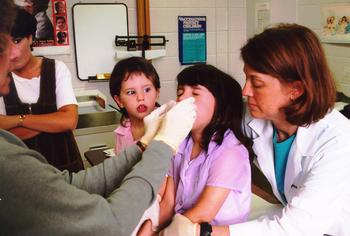Two new nasal spray vaccines target pediatric influenza, RSV

in the CRC, research nurses Jane Baker (right) and Judy Thompson test a nose spray vaccine on six-year-old Chandler Smith as her four-year-old sister, Kamryn, and her mother, Natalie, look on. (Photo by Matt Scanlan)
VUMC researchers are investigating the potential of new nose spray vaccines to address two common childhood diseases ‹ influenza and respiratory syncytial virus, or RSV.
Dr. Thomas G. Boyce, fellow in Pediatric Infectious Diseases, and Dr. James E. Crowe, assistant professor of Pediatrics, presented papers on studies of the two vaccines at the 1998 annual meeting of the Society for Pediatric Research.
The results from the nasal spray influenza vaccine may prove that nose drops are a more effective way of vaccinating children against influenza. Boyce¹s study showed that children who were given the new vaccine developed anti-influenza antibodies in their nasal secretions.
Influenza epidemics occur yearly and are a significant cause of respiratory illness throughout the world. Infection rates are highest in young children, often exceeding 40 percent. Current treatments are given by intramuscular injection and are not routinely administered to healthy children.
Vaccines work by stimulating the body's immune system to make antibodies against the infecting agent. It is unknown what types of antibodies are most effective in protecting against influenza.
"Traditionally, antibodies measured in the blood are used as a marker for protection. However, there is some evidence that antibodies in the nose, where the virus first enters the body, are more important for protection," said Boyce.
Knowing which types of antibodies the intranasal influenza vaccine stimulates will be important in refining future versions of the vaccine.
"In our study we sought to determine whether the intranasal influenza vaccine causes the production of local antibodies in the nose (mucosal IgA antibodies)," said Boyce.
To test the intranasal vaccine, researchers at Vanderbilt obtained nasal washes on 19 children before and after they had been given either the intranasal influenza vaccine or a placebo. They then tested the nasal washes for mucosal IgA antibodies to the three different influenza strains contained in the vaccine. The majority of children who had been given the vaccine developed mucosal IgA antibodies to all three influenza strains, whereas most of the children who received placebo did not.
"The nasal spray vaccine appears to stimulate the production of local antibodies in the nose, where influenza enters the body," said Boyce. "We hope these antibodies will stop the virus in its tracks, before it has a chance to spread to the rest of the respiratory system."
Further studies are under way to determine if the presence of these local antibodies correlates with protection from infection with the influenza virus.
The work presented by Crowe investigated the effectiveness of an intranasal vaccine against respiratory syncytial virus (RSV) in children. The study tested several different dosage levels of the vaccine in children as young as one-to-two months of age. The first dose conferred resistance against subsequent doses of attenuated virus.
"There are several vaccines that are getting very close to being used in practice ‹ the nasal influenza vaccine, the rotovirus vaccine, and, hopefully, the vaccine for RSV," said Dr. Peter F. Wright, professor of Pediatrics and Microbiology and Immunology, and lead author on the study presented by Crowe.
RSV is a viral infection of the lower respiratory system and is a common cause of pneumonia and bronchiolitis in young children. The disease is characterized by wheezing, and commonly takes its greatest toll on children younger than six months of age.
"RSV is one of the most common reasons for hospitalization in children. It is hoped that this vaccine, once perfected, will drastically reduce the number of those hospitalizations," said Wright.
The RSV vaccine is a live version of the virus that has been genetically altered so that it can not grow in the body temperatures found in the lower respiratory tract. The vaccine is administered by nose drops and infects only the cells in the upper respiratory tract, producing antibodies that are hoped to protect against future exposure to wild type RSV.
"We have been getting closer and closer to a vaccine that we can use for the youngest infant who is at special risk for the disease," said Wright
The first dose of this most recent vaccine did cause mild nasal congestion without fever or any signs of lower respiratory infection in 1 to 2-month-olds, so more attenuated vaccines will need to be examined. Subsequent injections did not produce these symptoms, showing an immune response to the initial vaccine.
"One problem we have had with previous vaccines is that they tend to revert to their normal genetic pattern and regain the potential to infect the lower respiratory tract. This new virus does not appear to do that. It is the most stable RSV vaccine yet," said Wright.
The next step will be to test further attenuated vaccines in a similar manner and then in a large number of children to show protection against wild type infection.













